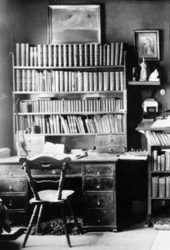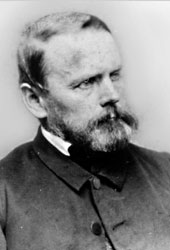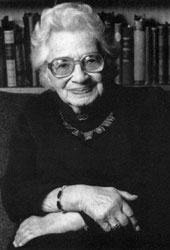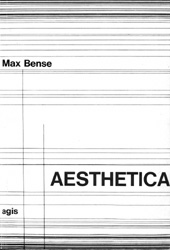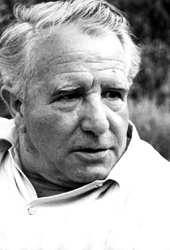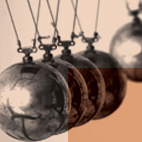 |
|
||||||||||||||||||||||||||||||||
|
|||||||||||||||||||||||||||||||||
|
Aesthetics at the College of Technology By Monika Jörg-Rössler It goes without saying that the engineering sciences were the main focus of attention and research at Stuttgart College of Technology. Nevertheless, aesthetics was one of the first humanities disciplines to establish itself here from the mid-19th century onwards. Through its work on demanding fundamental philosophical questions, captivatingly presented lectures and distinctive personalities, aesthetics has fascinated a broad audience from all fields of study throughout its history. Here we will present three famous figures. Friedrich Theodor Vischer Käte Hamburger Max Bense
Friedrich Theodor Vischer in TübingenAlthough Vischer was a feared unorthodox free thinker from the very beginning, he ultimately established his reputation at the University of Tübingen through his brilliance and precision.
Fighting spirit and rhetorical skillsBoth Vischer's life and his academic work often brought him back to Tübingen. His theological training took him twice to the Tübingen Seminary – once as a pupil, once as a teacher – and after obtaining his post-doctoral degree he was able to treat audiences to the first samples of his extraordinary oratory skills and energetic rhetoric when he was made Associate Professor at the university in 1837. Whether it was Faust, Aesthetics or Philosophy – Vischer was always meticulous in his preparation, identified completely with his subject matter and always lectured and spoke freely into ripe old age, often using dramatic phrases spiced with his unique humour. As a disputatious spirit, he made both friends and enemies in the University Senate, but his lectures were so popular with the students and so well attended that he could no longer be refused a Full Professorship in 1844 when he applied for the fourth time. He started his time as Full Professor in typical dramatic style and in his inaugural speech overstepped all the limits imposed by the Church and state. The "Vischer affair" became a political issue extending far beyond the state borders. To restore the peace the authorities banned him from teaching for two years. During this enforced break he set about writing his two ambitious works on aesthetics. Background information: inaugural speech Vischer's inaugural speech on 21 November 1844 caused an uproar, as some of the passages antagonised first his colleagues, then the Pietist Party and finally the king, which ultimately led to his two-year suspension. He made fun of the senators of the university, remarking that the state had no use for men whose fingers fell off in their rice pudding, and called upon academics to finally learn to walk tall with their chest out. He accused the senators of walking with dignity in their university gowns but of lacking the courage to step out of line, and said that professors with beards looked more dignified than ones without. In contrast to most professors, Vischer wore a beard. The Pietists saw his speech as a suitable opportunity to attack their long-standing opponent. With exaggerated, sometimes anonymous denunciations they tried to show that Vischer had mocked religion and the Church, had rejected Providence and declared that he no longer believed in religion. In fact, Vischer placed aesthetics above all other sciences – even theology – and finally settled an old score with the "scholastic manner of education" he hated so much. "... so I promise the enemy – in principle – a fight with no holds barred, I promise you – in principle – my complete and undivided animosity, my candid and heartfelt hatred." As Vischer was able to fend off the attacks and the Pietists were not able to force Vischer from his post as they had hoped, they turned to the king, to whom they presented Vischer's speech as though it were a rebellion against law and order. Despite numerous defences, debates and votes, Vischer's licence to teach was temporarily withdrawn, even though Vischer was admitted to be innocent.
First political activity and "exile"In addition to teaching, Vischer later tested the mettle of the politics of his time. More out of a sense of duty than out of ambition, he became a member of parliament for the left-wing democrats in the National Assembly in St. Paul's Church in Frankfurt, and was involved in the Stuttgart rump parliament of 1849. His commitment and spirited clashes with Pietism were not exactly beneficial to his standing in Tübingen society, which led him to "emigrate" to Zurich Polytechnic in 1855. Background information: Stuttgart rump parliament of 1849 After the failure of the Frankfurt National Assembly, a drastically reduced committee continued to hold session in Stuttgart between 6 June and 18 June 1849, and was eventually dissolved by the Württemberg military on 18 June.
The return to SwabiaIn 1866 Vischer returned as a professor from Switzerland to Tübingen and also took on additional teaching duties in Stuttgart. However, the tiny university town seemed too claustrophobic to him after having spent 11 years in the "great wide world" in Zurich, and, after a wearying struggle he succeeded in having a Chair for Aesthetics and German Literature founded at Stuttgart Polytechnic in 1869. Aesthetics in Stuttgart had finally been born. Yet over many years he was obsessed by the idea of moving the university from the petit bourgeois setting of Tübingen to the big capital city of Stuttgart. He even devoted a speech held on the occasion of the king's birthday to this topic – clearly to no avail.
Vischer in Stuttgart"Even if Vischer was to lecture on broom binding, I would attend the lectures."
Education for the widest audienceHis years in Stuttgart were a triumph for Vischer. His lectures were soon an integral part of the educational canon of Stuttgart society, and the students worshipped him too. His precisely and meticulously prepared lectures and speeches, with his inimitable free and flawless delivery, soon became his hallmark and made the Polytechnic, which had previously focussed almost exclusively on technical disciplines, into the educational heart of the capital. Soon it was the done thing to go to the opera, theatre and "to Vischer". His lecture cycles on German literary history and aesthetics were celebrated as pinnacle achievements in the very highest circles.
Goethe micrologists versus HegelVischer never worked in the evenings, spending his time in taverns with such famous figures as Mörike and Count von Zeppelin. Hegel and the writer Jean Paul were among his idols, and he never tired of battling against the type of philologists – who he referred to as "Stoffhuber" and "micrologists" – who tried to analyse the works of poets such as Goethe down to the most minute detail. "Was it six or seven, - When this verse he did pen? Perhaps half seven on the dot – When these words he did jot, - This genius, this wit?" Yet especially in his later years he became more reconciliatory and did admit that there were two opposing ways of seeing the truth: reading thoughts and reading pictures. "There need not be a dispute between aesthetics and philology." Background information: "micrologists" A "swearword" used by Vischer for philologists who obsessively focussed more on the meticulous analysis of trivial and circumstantial aspects of a poem rather than on the poem itself.
Vischer and aesthetics"... for it is only as an aesthetic phenomenon that existence and the world find eternal justification."
"On the sublime and the ridiculous"
Even during his time as a student, Vischer had been more fascinated by the subjects of philosophy, aesthetics and literature than by theology. In 1837 he completed his post-doctoral thesis, entitled “On the sublime and the ridiculous”, in which he expanded on Hegel's philosophy. Background information: historical transitional forms Vischer's aesthetics introduced enduring principles that remained constant over time into his understanding of "beauty". Hegel's aesthetics, on the other hand, proclaimed that concepts of "beauty" were subject to change.
The science of beautyWith his major work, the six-volume "Aesthetics of the Science of Beauty", written from 1846 to 1857, Vischer had created one of the most important universal aesthetic descriptions of post-Hegelian aesthetics. Vischer's wish was to continue, expand and complete Hegel's idealist aesthetics. In his work, he attempted to find a metaphysical justification for beauty. The "absolute idea" of beauty and the various forms in which it is realised in art and nature sublimates all "everyday" random aspects and contradictions by linking them to a "greater necessity" and thus leads to a reconciliation between "humans and the world". In this understanding, beauty functions as the last instance that helps humans to survive in the world. Whereas Hegel's aesthetics were primarily permeated by theological concepts, Vischer's aesthetics had a fundamentally different objective in mind. Its purpose was to put post-theological humanity into a deeper and immediate relationship with the world based on a new, non-theological aesthetic approach. Vischer wanted this work to constitute a complete aesthetic system. Yet he soon began to be plagued by doubts, and criticised his own work as early as 1873. He preferred to formulate criticism himself, as he found it difficult to tolerate criticism by other people. Background information: Vischer on his own aesthetics "The devil take it, the book drags me into insolvable doubts of self-knowledge." "It is all as though picked from the nose, rich in content, but knotty and twisted." "I constantly felt how broad it had become, yet could not stem my babble – mindless scrupulousness." The whole thing is and remains knotty, dry, unedifying."
What is the epic preterite?With her post-doctoral thesis "The Logic of Literature", published in 1957, Käte Hamburger managed to create a standard work of literary theory that immediately gained international renown. In it she revealed previously unnoticed narrative structures, primarily by asking unconventional questions of literary texts.
Tomorrow was Christmas ...Käte Hamburger was always both a literary scholar and a philosopher to equal degrees. She combined philosophical and literary issues even when she was a young student herself (studying History of Literature, Philosophy and History of Art, first in Berlin, then in Munich, where she completed her PhD in Philosophy in 1922), and in especially so in her PhD thesis entitled "Schiller's analysis of human nature as the basis of his philosophy of history and culture". In her work, she also tried to include poetic statements within the field of logic. Her main work, "The Logic of Literature", which she completed in 1956 at the age of 60 as her post-doctoral dissertation at what was then Stuttgart College of Technology, highlights the relationship between reality and fiction in various genres of literature. In it her main concern is to reflect on the basic grammatical preconditions of speech. She highlights the grammatical phenomenon of the "epic preterite". The stock formula of fairy tales "Once upon a time there lived ..." refers to a narrative time and nothing else. Only in literature can a sentence such as "Tomorrow was Christmas" make sense – a context in which we don't even notice its apparent grammatical impossibility.
Käte Hamburger and Universität StuttgartBorn in Hamburg into a bourgeois family, Hamburger was among the first generation of women in Germany to be able to study at university properly. In 1928 she went to Berlin and became the private assistant of Paul Hofmann (Associate Professor of Philosophy at Berlin University). As a Jew, she fled from National Socialist Germany in 1933 and spent 22 years in exile in Sweden, where she worked as a teacher and author. At a conference in Berlin on Thomas Mann in 1956, she was invited by Fritz Martini, then Full Professor of Literature and Aesthetics at Stuttgart, to come to Stuttgart College of Technology. At first she was involved in the so-called "educational subjects" and the General Studies programme, but soon enhanced the reputation of the College of Technology through her excellent lectures and seminars, and supported the expansion of the humanities. Thus from 1957 to 1977 she worked as a professor at Stuttgart, impressing both student and non-student audiences with her precise thinking and conceptual precision, as well as with her knowledge of a broad spectrum of European literature. As a philosopher and scholar of aesthetics she focussed on those authors who had written philosophical works or at least had been influenced by philosophy, such as Schiller, Novalis, Jean Paul, Sartre and Rilke, whose work she saw as poetic philosophy.
Käte Hamburger – her fame – her relationshipsAlthough she earned recognition late in life, recognition that from an academic point of view she had doubtlessly long since earned, she reached an extraordinarily large audience in the 36 years that she spent in Stuttgart. In 1989, for instance, she was awarded the "Schiller Memorial Prize" by the state of Baden-Württemberg in the New Palace in Stuttgart. Her remarkable achievements included two honorary doctorates (in Philosophy from the University of Siegen in 1980, and in Theology from the University of Göttingen in 1989). She had famous admirers such as the Weizsäckers, was awarded numerous honours by the academic world and the state, and was accompanied throughout her life by a large circle of academic friends such as Fritz Martini, Max Bense and Elisabeth Walther-Bense. Yet during her entire lifetime, her work was dominated by her acquaintance with and admiration for Thomas Mann, whose work had often been the subject of her research. Background information: Elisabeth Walther-Bense Elisabeth Walther-Bense, born in 1922 in Oberweißbach in Thuringia, studied at the universities of Jena, Mainz and Stuttgart College of Technology. She taught Philosophy at the college, which was later to become a university, for almost 30 years. Together with Max Bense, Elisabeth Walther co-edited the "rot" series of publications and the "Semiosis", the international journal for semiotics and aesthetics. The main focus of her work is semiotics, aesthetics, pragmatism and research on Peirce.
Discovering aesthetic truth with Käte Hamburger"The concept of truth is constituted by being identical to what is the case."
Concepts put to the testPrecision was the maxim of Käte Hamburger's life and thinking. She demanded conceptual precision and linguistic accuracy from both her students and conversation partners. Even renowned experts were not safe from her remorseless analyses. She referred to vague use of language or inaccurate interpretations of concepts in the works of such famous figures such as Schiller, Lessing or Schopenhauer as "illustrious flawed thought". Her major works dealt with concepts such as literature, humour, truth and pity. In her work "Truth and Aesthetic Truth" she investigates the concept of truth in all its forms. The main target of her scrutinising analysis is "aesthetic truth" and the problem of truth in literature.
The two sentences Hamburger shows how often writers and artists themselves equate aesthetics and truth in a completely unproblematic and matter-of-course manner: for Schiller, for instance, "a poetical description is absolutely true", and the painter Max Liebermann describes poetry as Artistic Truth that "grasps the essence of nature through genius". Yet semantic considerations make it impossible to apply the term truth to the interpretation of works of art, nor can truth be shown to be "aesthetic truth", as this is a contradiction in itself. Background information: the concept of truth There is hardly any other fundamental concept in the history of philosophy that has been given so many different interpretations. Many attempts to precisely define the concept have been based on Thomas Aquinas's classical adaequatio formula for truth: Veritas est adaequatio rei et intellectus (Truth is the correspondence between reality and the mind).
Programming beautyIn a technology-based society there is no longer any fundamental difference between scientific and artistic production. Aesthetics ceases to lead the dubious existence of a speculative philosophical science and increasingly develops into a technical science, which can be produced by new media and can be programmed.
Bense moves to Stuttgart College of TechnologyAfter having studied Physics, Mathematics, Philosophy and Geology at the University of Bonn, Max Bense completed his Dr. phil. nat. thesis in 1937, entitled "Quantum Mechanics and the Relativity of Existence". After working as a physicist and mathematician, and serving a period of military service, he completed his post-doctoral thesis after the war at the University of Jena. Yet he soon realised that the political climate in the East didn't provide him with the academic freedom he was looking for, and left the Soviet occupied zone, leaving his possessions behind and without a new job to go to in the West. Even at this early stage he provoked the regime in typical style in his last lecture, attacking the Soviet philosopher Alexandrov, which thus led to the first "Bense affair". Like with Käte Hamburger seven years later, Fritz Martini was the driving force who recommended Bense to apply for a visiting professorship in Philosophy and Theory of Science in 1949. Bense was given the post, beating fellow applicants Pascual Jordan and Carl Friedrich von Weizsäcker, and was subsequently made Associate Professor on 1 October 1950 and Full Professor on 23 March 1963 of the newly founded Chair of Philosophy and Theory of Science at Stuttgart College of Technology.
Numerical aesthetics and semiotics in StuttgartBense's many years of renown were due not least of all to his lively, anti-academic style of lecturing, which he underlined with a great deal of gesticulation before audiences consisting of a colourful mixture of intellectuals and lay philosophers from all walks of life. "But first and foremost it was probably the intellectual systematicity behind the obsessive gestures during Bense's performance that fascinated many people, the lack of respect for established conceptual clichés and lofty words." Like Vischer 100 years previously, Bense's lectures brought a large audience to Stuttgart College of Technology. His exemplary academic research into semiotics and numerical aesthetics was in one sense an attempt to unite the natural sciences and the humanities. The semiotics of Charles Sanders Pierce, which Max Bense, Elisabeth Walther-Bense and their many students had expanded upon, were the real research focus at the Stuttgart institute from the late 1950s onwards. This led to a large number of international contacts and, importantly, to the foundation of the "Semiosis" journal for aesthetics and semiotics. Many other of Bense's countless achievements for Universität Stuttgart could be mentioned – the following may serve as an illustration:
Background information: Elisabeth Walther-Bense Elisabeth Walther-Bense, born in 1922 in Oberweißbach in Thuringia, studied at the universities of Jena, Mainz and Stuttgart College of Technology. She taught Philosophy at the college, which was later to become a university, for almost 30 years. Together with Max Bense, Elisabeth Walther co-edited the "rot" series of publications and the "Semiosis", the international journal for semiotics and aesthetics. The main focus of her work is semiotics, aesthetics, pragmatism and research on Peirce. Background information: Charles Sanders Peirce Peirce (1839-1914) was one of the founders of American pragmatism. As a mathematician, philosopher, chemist and geodesist, he saw his vocation in the philosophy of science and logic. He was the founder of modern semiotics. Background information: semiotics and numerical aesthetics Information aesthetics, which makes use of semiotic and mathematical methods, describes the aesthetic states that can be observed in nature, artistic objects, works of art and design by means of numerical values and categories of signs. Both Bense's "Theory of Texts" of 1962 and his information aesthetics were based on the work of engineers such as Claude Shannon or mathematicians such as George Birkhoff, from whom he took over the formula M = O/C, which represented a measurement of aesthetic states. The formula calculates a relationship between the "order" and "complexity" of an aesthetic object, i.e. a relation between ordering factors such as symmetry or the elementary set of an object such as the number of lines in a computer graphic.
Beauty is taken into the outside world – the Study Gallery – the Stuttgart SchoolBense's innermost desire was always to objectify aesthetic criteria. Thus the term "objective aesthetics" became the key concept in his artistic understanding. The first exhibitions whose conceptualisation and organisation Bense was involved in were held in 1957 in cooperation with the "Gänsheide 24 Gallery", one of the few galleries at the time dealing with avant-garde art. Shortly afterwards he founded one of the first university galleries in Germany as part of the General Studies programme – the Study Gallery. It became an important forum for experimental art, with frequent exhibitions by internationally acclaimed artists. From 1965 the public were able to see a complete novelty: works of art that had been produced with the help of "computational processors", exhibited under the title of "computer graphics".
The "Stuttgart School" is further evidence of Bense's wide-ranging intellect. The school consisted of a group of artists, literary figures and "free-floating spirits" who were attracted by Bense's concept of aesthetics and his radicalism, and was thus a more non-university grouping. (The group's actual name was devised not by Bense himself, but by the author Manfred Esser, who spoke of the provocative theories of this Stuttgart school at a conference of the French "Tel Quel" group in Normandy, whereupon French and German newspapers immediately picked up on the term.) Background information: stochastic texts
Texts whose words are determined at random. Sentences or sentence fragments are randomly selected by rolling dice or other random processes, and are then arranged together. Debate centred around whether such artefacts could be classified as art. Compare the works of Theo Lutz, a former student at the Computer Centre of Stuttgart College of Technology:
The second Bense affairLike in his lectures at university, Bense was outspoken and forthright in front of non-university audiences too. His unmistakably hostile remarks about the Church and the Pope led to heated disputes on the "Bense affair" in the Baden-Württemberg parliament. On 4 December 1970 Max Bense was interviewed in the "Stuttgarter Nachrichten" newspaper, during which he was asked about the attack on the Pope in Manila:
"Question: Would you also be capable of pulling a knife on someone, on the Pope for instance? Initiated by the Church, a debate began during which the Christian Democrat parliamentary party called for Bense to appear before a disciplinary hearing and for him to be immediately dismissed from his post. Other parties also reacted with fierce attacks on him. After a huge political uproar and debates on academic freedom, which led to several politicians having to resign, Bense published an extensive public defence and was allowed to continue teaching. Background information: public defense Bense wrote a open letter to Prime Minister Filbinger defending himself against the accusation of glorifying violence. However, he did not retract from his critical stance towards the Church. Bense closed the letter with the words: "Enlightenment is not a reversible process, and a professor who does not enlighten others has failed to fulfil his role."
Aesthetics and technology"[...] it is not the atom bomb that is the key technical event of our age, but the construction of large-scale mathematical thinking machines. They are extraordinarily universal in nature, they are at the same time technological, mathematical, logical, sociological and neurological principles [...]" As early as 1954 onwards, Bense showed in his work "Aesthetica" that we live in a world whose reality is to a large degree artificial and technological. This insight allowed him to derive an innate connection between art and technology, aesthetics and construction. Art and technology can both possess beauty, and thus can be given aesthetic justification. Both are "made" or "constructed". The difference lies in the finer structure of the two forms. A technical construction such as a machine, consists of interconnected parts, with each part having a specific function. A work of art, on the other hand, has an independent aesthetic existence, it does not function but simply exists. Art and technology can be brought closer together through the concept of "completeness". Completeness is a state of both artistic and technological forms. Completeness is part of aesthetics and of construction. "How close the involuntary connection between a work of art and a product is can be demonstrated by juxtaposing sculptures and cars taken from the same period." Thus the familiar classical aesthetic terms of "artistic beauty" and "natural beauty" can be complemented by a third term, namely "technical beauty". Aesthetics is among the disciplines that mediate between the natural sciences and the humanities, and, like any other science, has its own philosophical basis. It is not an exhaustive system, but an as yet incomplete theory, and thus an open science that must remain in need of completion, revision and evaluation.
The legacy of aestheticsThe lectures and research of Vischer, Bense and Hamburger all provided a strong humanities-based counterbalance to the technical orientation of the Stuttgart college, a counterbalance whose reputation went far beyond the borders of the state capital. Over more than 130 years they made their mark on the profile of the humanities in Stuttgart, while managing to fascinate society as a whole with their subjects. Vischer's lecture courses, Bense's Monday lectures and Hamburger's commitment to the General Studies programme have certainly made major contributions to Stuttgart's rich academic atmosphere. It was not least of all due to Bense's efforts to introduce the right to award doctorates in Philosophy that Stuttgart Technical College was later honoured with the title of "University".
Biography: Friedrich Theodor Vischer (1807 - 1887)In 1869 Vischer was made senior teacher at Stuttgart Polytechnical School in the newly founded German Literature and Aesthetics teaching and research institute.
Biography: Käte Hamburger (1896 - 1992)Käte Hamburger built bridges between philosophy and literature studies, and made major contributions to literary theory and aesthetics.
Biography: Max Bense (1910 - 1990)Bense worked as Professor of Theory of Science at Stuttgart College of Technology from 1950 onwards, where he founded his numerically-based aesthetics.
|
|
Last updated 04/10/2006 ( |
